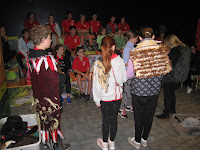Today we had a fascinating trip to the Te Awamutu Museum to learn about the Treaty of Waitangi.
We firstly looked at the situation before the treaty and the students got to dress up in costumes to represent the tangata whenua, sealers, whalers, traders, convicts, Busby, and Hobson. People were getting unruly and the Maori wanted change to the way their land and people were being treated. Busby and Hobson were expected to acquire land for immigrating British. The students then were shown the steps that led to the treaty.
The Treaty of Waitangi was signed in 1840. Maori were shown the treaty and then given the choice to sign. Hone Heke was the first to sign and eventually over 500 Maori signed. The problem was that Maori were unfamiliar with the language of the treaty and signed without understanding exactly what their signing meant. They thought that by signing they would get greater protection and that decisions about land would be made in partnership with the British. However, the British saw the treaty as giving them the right to govern, buy, and administer the sale of land. This difference is what has led to all the struggles around land ownership in NZ.
The students looked at a massive version of the treaty. It was discussed that the overarching principles of the treaty were participation, partnership, and protection. The students then decided if they would sign to commit to these three things and then got to sign the treaty with a quill.
So much learning and it felt like we only scratched the surface.







Wow looks like a cool trip - looking forward to going next week....
ReplyDeleteFantastic, looks like some great learning going on there...
ReplyDelete